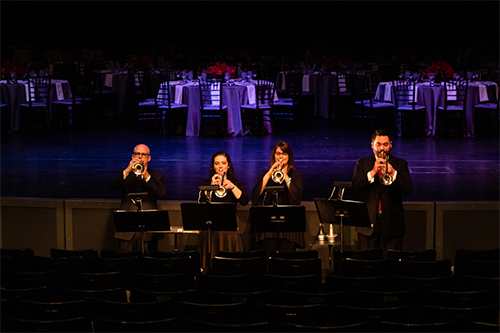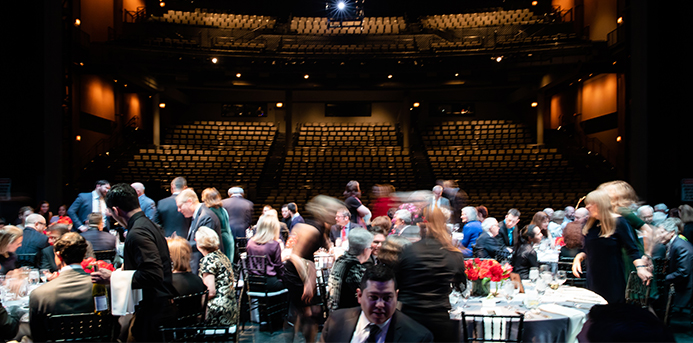How appropriate that a 15th anniversary is commemorated in crystal because, to experience the flawless staging of world-class entertainment by Chicago’s Joan W. and Irving B. Harris Theater for Music and Dance for the past decade and a half, is to see only the tip of the iceberg.
On Feb. 22, the Harris celebrated this jubilee by honoring its founders — Joan W. Harris, Sandra P. Guthman, and Sarah Solotaroff Mirkin — for their vision, commitment, and passion in making the Harris Theater a reality. During the 15th Anniversary Founders Dinner, 175 guests enjoyed cocktails and hors d’oeuvres before dinner on the Harris stage. Performers included Fulcrum Point New Music Project; soprano Nicole Cabell; Giordano Dance Chicago (Harris Theater Resident Company); and Nathanael Wilkerson, a senior at Chicago High School for the Arts.

“We really started working on the theater in 1993,” says Guthman, founding chairman and trustee, emphasizing that creating a home for Chicago’s small to mid-sized music and dance repertories is an idea that has actually been 30 years in the making.
“For (these companies), performing in a venue the size of Orchestra Hall made no sense,” explains Mirkin, Harris’ life trustee, whose job as a grantmaker at the outset was to recognize the needs of the city’s artistic community. “They would be paying a whole lot of money in rent … and they wouldn’t be generating enough ticket money to make it financially viable.”
The question of size, then, had been the major factor in the Harris’ creation. The intimate, 1,500-seat theater, which now stands at the northern edge of Millennium Park, is today the go-to place for signature Chicago repertoire companies like Hubbard Street Dance Chicago and Chicago Philharmonic.
“There’s an intimacy that goes along with being as small as we are,” says Abby M. O’Neil, founding trustee and past chairman. “The sight lines are fabulous. The acoustics are superb. There are no bad seats in this house.”
Providing subsidized rental for music and dance companies was the theater’s original, and singular, purpose. The founders could not have envisioned, however, that within a few short years they would not only be fulfilling this mission but also expanding it to include the honor of presenting world-class national and international companies themselves.
“We now have been able to attract artists from all over the world,” says Patricia Barretto, president/CEO. “It creates a halo effect for all the other artists that perform here.”
Harris calls that a win for everybody. “The national and international companies get to have a presence here, and the local companies get to share the stage with some of the most important performing companies in the world.”

Renowned for its diverse ethnic communities, Chicago is also considered the theater capital of America, boasting more than 250 theaters from large to storefront. The Harris heeded the artistic community’s calls for a stage that could showcase the rich assortment of entertainment on offer and presented it with an international spotlight.
“When there is a variety on stage, there is automatically a wonderful variety sitting out in the seats. (It) represents the fabric of the world,” says Barretto.
For Guthman, who began as a dancer at Wellesley College and had risen to chairman of the board of Hubbard Street Dance Chicago, it is important that the Harris be open, accessible, and welcoming to everybody.
“We are building a level of trust in our curatorship. That means diverse programming,” says Guthman.
It also means making the theater accessible to all with ticket prices that range from $10-$200.
From the Chamber Music Society of Lincoln Center to “The Trial of Hippocrates” by the National Hellenic Museum, from Gauthier Dance//Dance Company Theaterhaus Stuttgart to the ambassadors of South African culture Ladysmith Black Mambazo, the annual lineup of some 140 diverse productions, by both resident and guest troupes, translates to an intercultural range of choices.
“Our programming is now a very healthy and robust mix of local companies, national and international artists,” says Harris.
That is music to the ears of the thousands of artists plying their craft, and to the more than 100,000 individuals who visit the Harris annually to appreciate them.
“The arts are such an important part of our collective humanism,” says Alexandra Nichols, board trustee since 2000. “Especially at this time when the arts, in all their variety, are under siege … it’s important for all of us to be enthusiastic sponsors of arts organizations and appreciate the relevancy of them in our lives.”
 Erstwhile columnist/photographer for the Daily Herald and currently 22nd Century Media, for the past 12 years Lee A. Litas has likewise been a dining and trend columnist and photographer for Pioneer Press, first under the Chicago Sun-Times and now under the Chicago Tribune umbrellas. Hailing from a half-Greek/half-Russian family where “filoxenia” was the way of life, Litas now makes it her business to find the juiciest morsels, both newsy and edible, wherever she travels. Graduate of The American Graduate School of International Management-Thunderbird and Indiana University’s Ernie Pyle School of Journalism; polyglot, all-around gadabout, and Argentine tango dancer — not all at the same time, mostly.
Erstwhile columnist/photographer for the Daily Herald and currently 22nd Century Media, for the past 12 years Lee A. Litas has likewise been a dining and trend columnist and photographer for Pioneer Press, first under the Chicago Sun-Times and now under the Chicago Tribune umbrellas. Hailing from a half-Greek/half-Russian family where “filoxenia” was the way of life, Litas now makes it her business to find the juiciest morsels, both newsy and edible, wherever she travels. Graduate of The American Graduate School of International Management-Thunderbird and Indiana University’s Ernie Pyle School of Journalism; polyglot, all-around gadabout, and Argentine tango dancer — not all at the same time, mostly.

